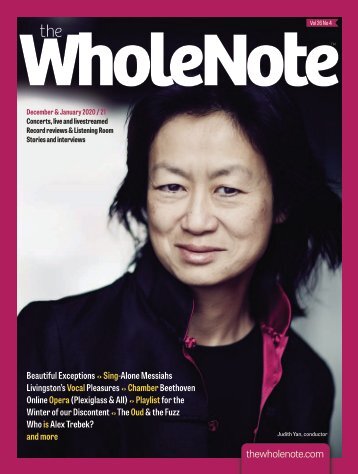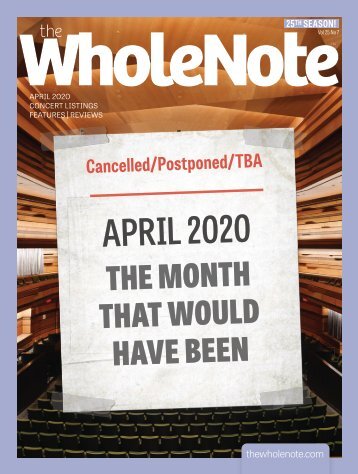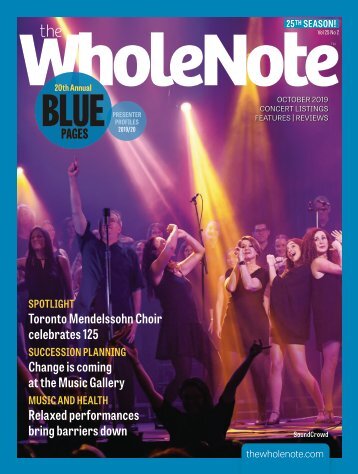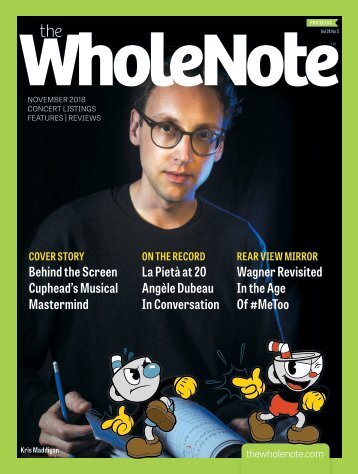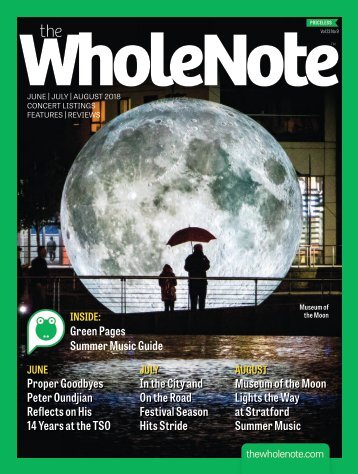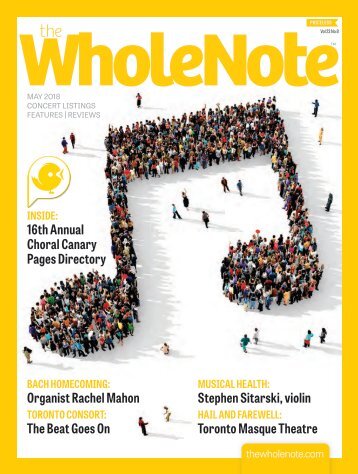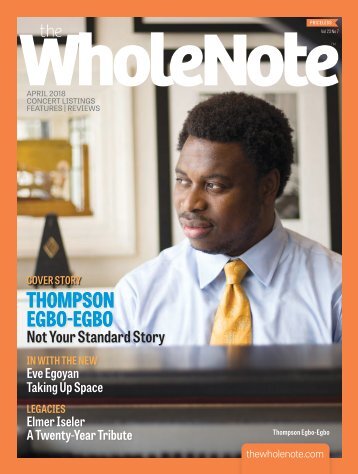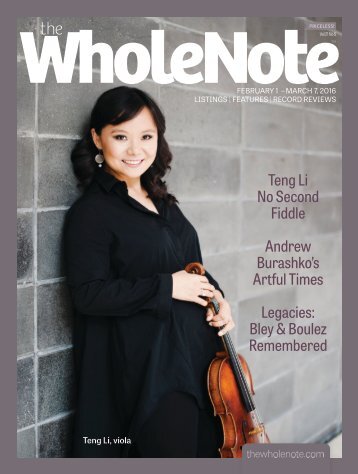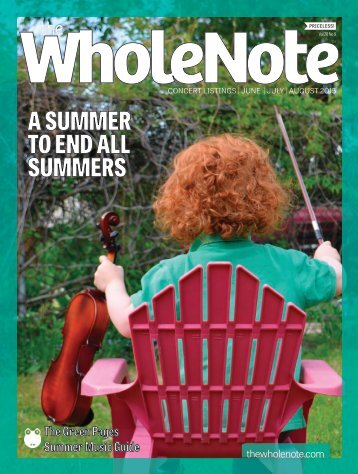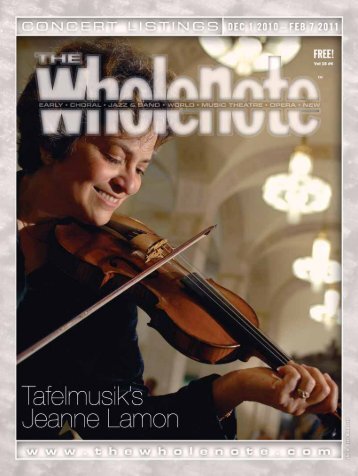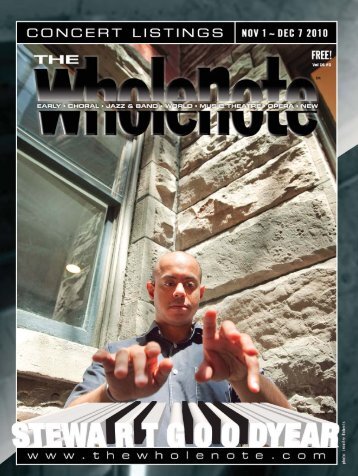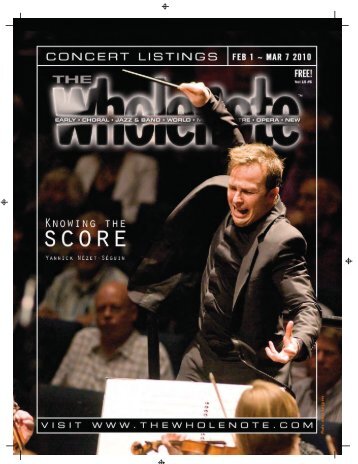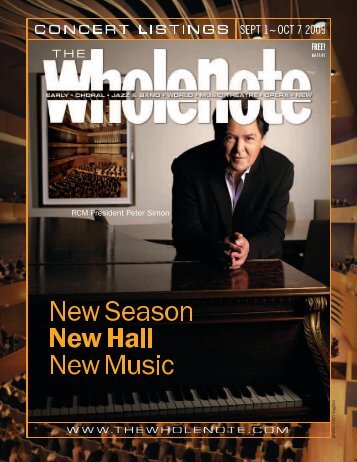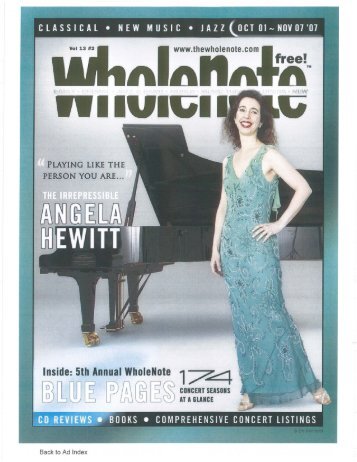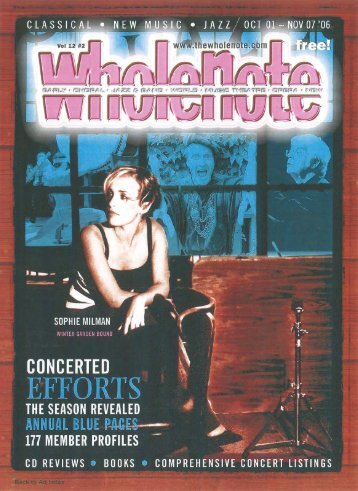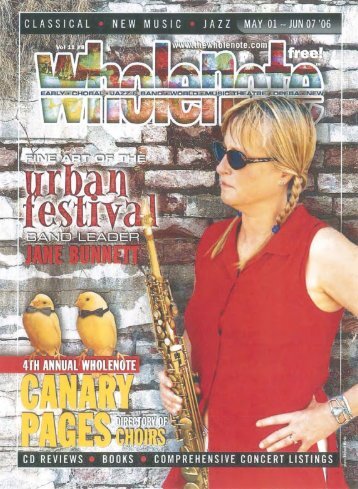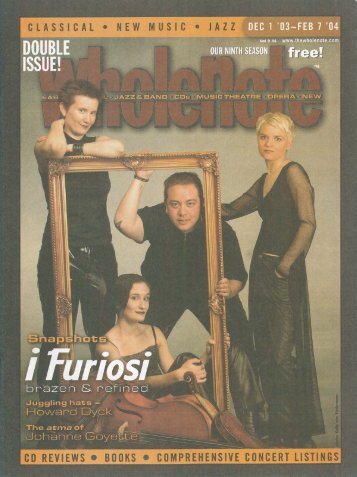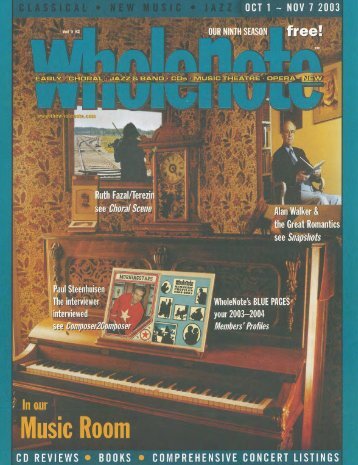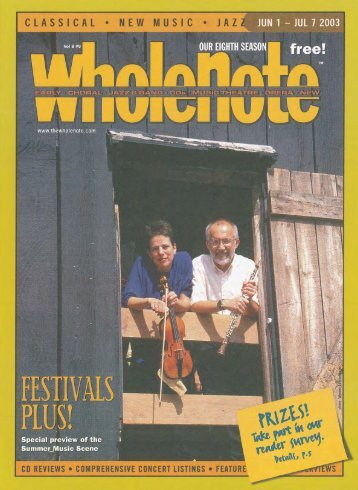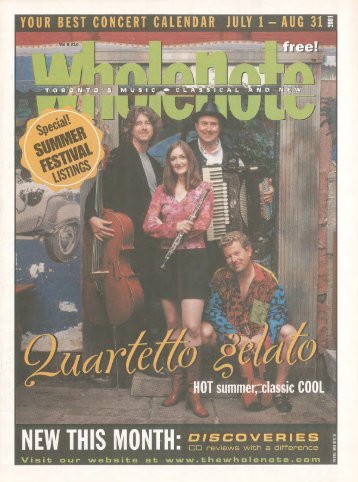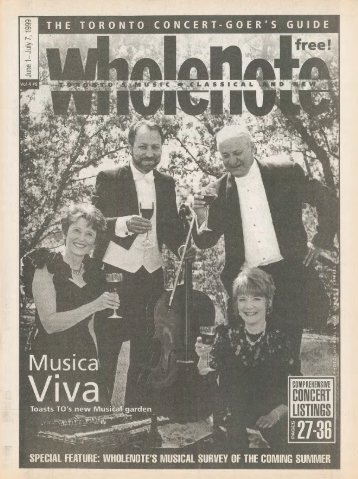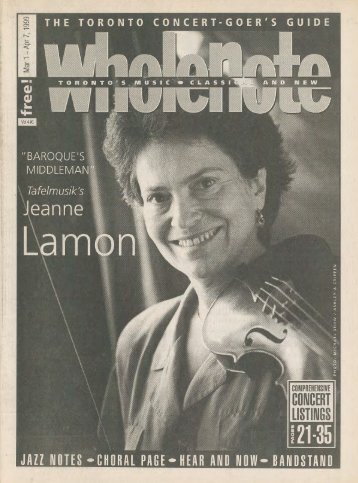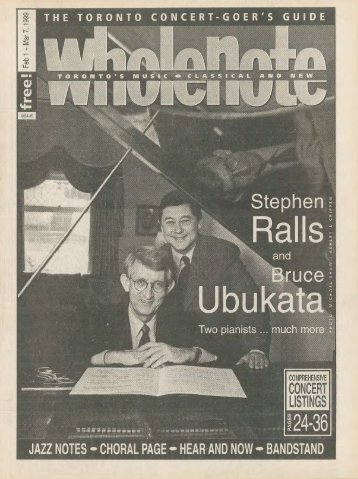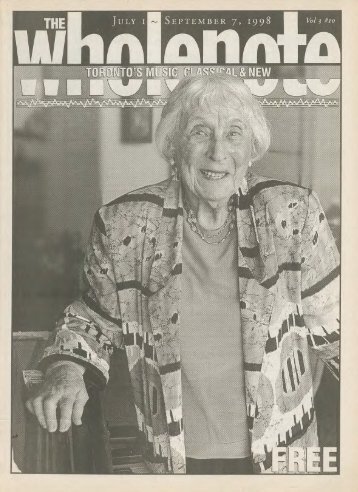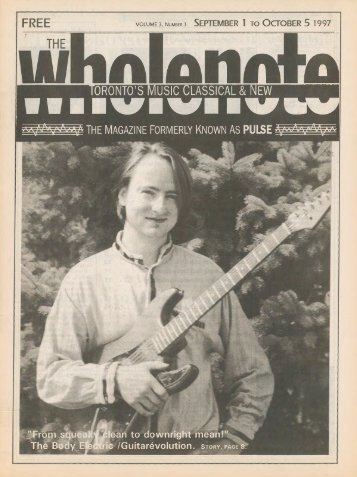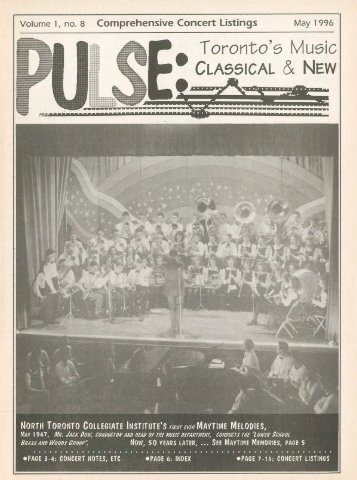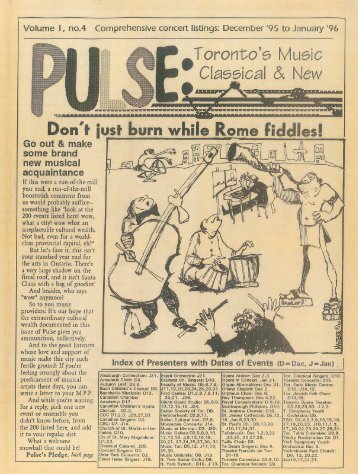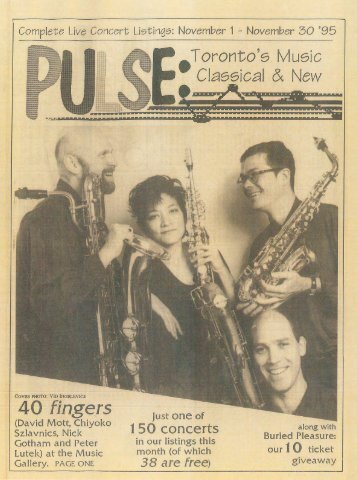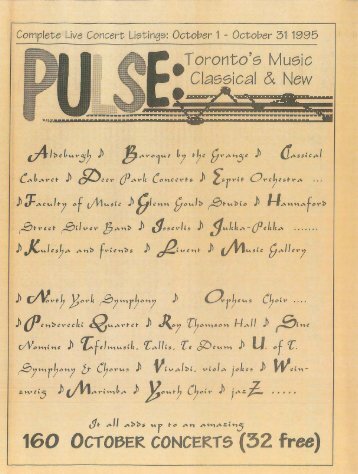Volume 20 Issue 4 - December 2014
- Text
- December
- Toronto
- Jazz
- January
- February
- Symphony
- Arts
- Bloor
- Theatre
- Orchestra
producer, he has
producer, he has previously recorded threeCDs of this repertoire and has recentlyunveiled a 6-CD collection of music from theGalician (Western) region of Ukraine witheven more yet to come.The first disc in this set also serves to introduceus to the team of celebrated Canadianvocal artists that has given life to this ambitiousproject. In addition to Hunka’s ownpowerful voice, they include sopranos MonicaWhicher, Nathalie Paulin and mezzo-sopranoKrisztina Szabó, tenors Benjamin Butterfieldand Colin Ainsworth, and baritone RussellBraun, with additional support from pianistsCarolyn Maule and Serouj Kradjian. Thisinitial volume is devoted to the art songsof Denys Sichynsky (1865-1909) whichdate mainly from the twilight of romanticism.They are typically declamatory, earnestminor key laments with often quite elaboratekeyboard parts, dispatched with panacheby the expert pianist Albert Krywolt, whoaccompanies the lion’s share of the songs inthis anthology.The long life of Stanyslav Liudkevych(1879-1979) requires two CDs to tell hisstory. Though the majority of the 28 songs onoffer date from the early 20th century, thecomposer was still active into the mid-1960s.His harmonic language is often daring andfreely modulatory and the ingenious texturesof his piano accompaniments suggest anorchestral conception. Eclecticism aside, it’snonetheless clear that a major talent is ondisplay here. The first CD is so totally dominatedby male voices that the sole exceptionsung by Nathalie Paulin comes as quite arelief. Fortunately the second CD is more judiciouslyshared between the genders.A tragic figure, Vasyl Barvinsky (1888-1963)was the director of the Lysenko Institute ofMusic and its successor institution the LvivConservatory and maintained a commandingprofile both locally and internationally.In 1948 however, political intrigues broughthim crashing to earth. He was arrested, hismusical scores were publicly burned in theConservatory courtyard and he was sentencedto spend the next decade toiling at a labourcamp in the backwaters of Mordovia. Hespent the remainder of his life attempting toreconstruct his musical legacy, which is stylisticallyindebted to Debussy yet always strikinglylyrical. Fortunately compositions he hadconsidered lost forever are slowly coming tolight from Western sources. The majority ofthe selection of 17 songs are shared betweenHunka and the excellent soprano Szabó andinclude some beautifully rendered violinpassages by Annalee Patipatanakoon.Though described as a “modernist,” thereis little to fear from the passionate and oftendeeply autobiographical music of StefaniaTurkewich (1898-1977). Stylistically it doesnot go far beyond the extended tonality ofthe earliest works of Alban Berg. A pupilof Barvinsky, she went on to study withSchoenberg and Schreker in Berlin in the1920s and subsequently worked in Lviv.Acclaimed as the first Ukrainian womancomposer, she emigrated to England in 1948,where she sought recognition in vain withinthe intensely insular post-war British musicalestablishment. Hunko and company makejust emends for her neglect in this extensiveselection of 20 songs, including two winningand resolutely tonal English-languagenursery rhymes.A sixth compilation disc completes the set.The recordings are accompanied by a lavishbooklet with texts and translations in fourlanguages. Seamless and consistent audioediting throughout is credited to veteranproducer Doug Doctor at the helm in GlennGould Studio. A most welcome and innovativeaspect of the project includes makingnewly engraved editions of the scores ofthese neglected gems freely available throughukrainianartsong.ca. The album may also beordered there as well as through iTunes.Daniel FoleyEARLY MUSIC AND PERIOD PERFORMANCEMetamorfosi – Impressions BaroquesSuzie LeBlanc; ConstantinopleAnalekta AN 2 9142La Veillée de NoëlSuzie LeBlancATMA ACD2 2523Featuring the musicof Barbara Strozziand her mentorsand contemporaries(Monteverdi,Kapsberger, Rossi,Merula and Landi),the incomparablesoprano Suzie LeBlanc has teamed upwith a most remarkable ensemble. In thisrecording, Constantinople looks to the earlybaroque with its well-established techniqueof infusing early and contemporary Westernmusic with Persian musical traditions. Andthe repertoire of 17th-century Venice lendsitself very well to the fusion, with its owntradition of highly-ornamented stylization,resulting in an intricate and marvellous interpretation.Joining the Tabassian brothersKiya (setar) and Ziya (percussion) are EnriqueSolinis (baroque guitar/theorbo), Pierre-YvesMartel (viola da gamba) and Miren Zeberio(baroque violin). Unique exchanges aboundamongst the instrumentalists, particularlyin the Kapsberger selections, ever shiftingin rhythmic nuance. It is a delight to hearLeBlanc interpret the songs of Barbara Strozzi,a singer and composer known as much forher intellect, learning and wit as her talentand beauty. LeBlanc skillfully captures herspirit. Her profoundly moving performanceof Monteverdi’s Si dolce è il tormento bearswitness to a wide range of emotion encapsulatedin its simple strophic form.This has provento be a particularlyprolific year forLeBlanc. A scholarin her own right, shehas also been busy oflate researching rareChristmas tunes fromFrance and Acadia, resulting in the releaseof a lovely collection on her latest CD, LaVeillée de Noël.Dianne WellsGiovanni Felice Sances – Complete Arias,1636Bud RoachMusica Omnia mo0611Bud Roach startedhis professional careeras an oboist (he playedin several Americanorchestras) but morerecently has concentratedon singing andconducting. He is thedirector of CapellaIntima, which in recent years has given usperformances of the anonymous Giuseppeand of Gagliano’s Dafne. Both as a singer andas a director he specializes in Italian work ofthe early 17th century. His first recording asa tenor was of songs by Alessandro Grandiand he has now followed this up with a CDof arias by Giovanni Felice Sances, music firstpublished in 1636. On both recordings heaccompanies himself on the baroque guitar. Iheard him perform these works at the BostonEarly Music Festival Fringe in July 2013 and itgave me pleasure to renew my acquaintancewith them. The final song on the disc (Accentiqueruli) is not part of the 1636 edition: it is achaconne which was such a prominent andinfluential form in the early baroque.Roach’s voice is light but clear anddistinctive; he has no problem with the hightessitura of many of the songs. Throughout hesings with real expressiveness. These songscan be seen as part of a Petrarchan traditionof erotic poetry but at the same time theyshow an affinity with popular song. Theyare now little-known and under-performed.Roach deserves credit for bringing this repertoireback to life.Hans de GrootCouperin – ApothéosesGli Incogniti; Amandine BeyerHarmonia Mundi HMC 902193It is crystal clearthat this recordingis a labour of loveand full of vibrancyand personality. Thesix instrumentalistsof Gli Incognitithrow themselvesinto Couperin’s76 | December 1 2014 - February 7, 2015 thewholenote.com
music, infusing it with youthful vigour andairy spontaneity.The program is bookended by sonatas – LaSuperbe and La Sultane – both played withexquisite attention to detail and “French”virtuosity, i.e. a wide vocabulary of freshornamentation that gives one the idea thateverything is being improvised. ViolinistsAmandine Beyer and Alba Roca are perfectlymatched and dance around each other withgreat subtlety. Equally impressive is thecontinuo team: solid as a rock and addingheft and/or tenderness where needed.The major pieces – Couperin’s Apothéosesde Lulli et Corelli – are works of tremendousscope, based on Couperin’s intended philosophicaldesire to reunite the tastes and stylesof Italian and French instrumental music.They are programmatic, multi-movementmasterpieces and the performances on thisdisc are very fine. My only argument is withthe tempos of some of the more transparentmovements. There is a driving quality to thegroup’s playing that is immensely attractivemost of the time; however, some of theethereal, transparent movements need moredreamy air and space – and could simplybe slower.Special mention must be made of thegorgeous, sensuous gamba playing ofBaldomero Barciela and Filipa Meneses in LaSultane. Their performance of this sonata isworth the price of the CD alone.Larry BeckwithConcert Note: Gli Incogniti’s leader, violinistAmandine Beyer, is the latest guest directorwith Tafelmusik this month, in a Frenchprogram – including a violin concerto byJean-Marie Leclair – with performancesDecember 4 to 7 in Jeanne Lamon Hall atTrinity-St. Paul’s Centre.Stradella – DuetsSusanne Rydén; Emma Kirkby; SergioForesti; Harmonices Mundi; ClaudioAstronioBrilliant Classics 94343AlessandroStradella’s private lifehas created a wave ofspeculation althoughit is clear that he waskilled in Genoa in1682. His untimelyend deprived Italianmusic of an exceptionalcomposer. On this CD, however, weenjoy the voice of the singer who is formany both the face and the voice of earlymusic, Dame Emma Kirkby. She appearson eight duets, commencing with the livelyCara labbra che d’amore. More intense isPazienza, finirá l’influenza with its sombrestringed introduction and continuo. HereSusanne Rydén and bass Sergio Foresti conveya message of hope, even though Foresti’s bassand the continuo still combine to producea certain overshadowing darkness. Kirkbydisplays a real intensity with her interpretationof Ahi, che posar non puote, a duet withForesti, where her skills are at their finest.For Rydén, one of the most testing piecesmust be Fulmini, quanto sa quel sembiantesevero – the musical elements portraying thearrows of emotion are clearly recognizable.For Kirkby the test of how to demonstratepictorial qualities in music comes in Ardo,sospiro e piango, where dissonance is used toevoke musical sighs. Dietro l’orme del desio isanother highly demanding duet. Many of theclassic Italian devices are employed to greateffect; for example, in one passage, in additionto difficult notes, pauses underline themeaning and rhythm of words.There is no doubt that listening to thisrecording confirms the loss to music whenwe think what Stradella might have gone onto compose and also Dame Emma Kirkby’splace in early music.Michael SchwartzBach – The Art of the FugueAngela HewittHyperion CDA67980Four years ago,Hyperion released allof Canadian pianistAngela Hewitt’srecordings of Bach’ssolo keyboard worksas a 15-disc boxed set.It was a huge project,but it didn’t includeBach’s monumental late work, The Art of theFugue. Hewitt has now tackled this set of18 fugues and canons, which she describesin her detailed booklet notes as “completelyoverwhelming, both intellectually andemotionally.”Hewitt’s stylistic trademarks are here– dancing rhythms, nuanced touch andsparkling clarity. She colours each voice sodistinctively, you can hear right into thecomplex textures. But her greatest achievementis to reveal the spiritual depth thatsuffuses this work. It becomes not just anexploration of all the things counterpoint cando, but an exploration of just about everythingthat music can possibly do – andthen some.Bach never specified the instrumentationfor this work. Hewitt makes as convincing acase for performing it on a modern piano asany I have heard, especially with an instrumentas responsive as her Fazioli.Bach’s score ends, enigmatically, part waythrough the final fugue. Most performanceseither stop there, or add on a completion inBach’s style. Following the original edition,Hewitt stops mid-fugue, pauses, then playsBach’s “deathbed” chorale prelude Wenn wirin höchsten Nöten sein (When in the hour ofutmost need), which C.P.E. Bach copied intothe score after his father’s death. It makes foran intimate and moving finale.Pamela MarglesConcert note: Angela Hewitt appears withsoprano Anne Sofie von Otter in a recital ofsongs and solo piano works by Beethoven,Schubert, Brahms, Fauré, Debussy and othersat Koerner Hall on January 9.CLASSICAL AND BEYONDHummel – Piano Trios 1Gould Piano TrioNaxos 8.573098Johann NepomukHummel (1778-1837)was an influentialcomposer, virtuosopiano performer anda well-known teacherduring his lifetime. Hewas a student of manyfamous teachers:Clementi, Mozart, Albrechtsberger, Salieriand Haydn. His friends included Beethoven,Schubert and Goethe. He wrote beautifulmusic, mostly for piano, but also exploredother less popular instruments (such astrumpet and guitar), and made Weimar aEuropean musical capital while he was activethere. Hummel’s musical aesthetics werefounded on a classical model of clean linesand balanced melodies, at a time that wasgiving birth to a new wave of bravura pianoplayers and general discontent with musicalconventions. The world’s obsession with theromantic ideals could be the main reasonwhy Hummel’s music was forgotten afterhis death.The piano trios on this recording werewritten over the span of 15 years and featureall the elements of the classical style but alsooffer a wealth of melodies and fresh musicalideas. Each trio, for example, features a Rondoas the concluding movement, but each Rondocomes with its own style, whether borrowingmotifs from Turkish or Russian musical traditionsor introducing scherzo elements andsurprising modulations.The Gould Piano Trio (Lucy Gould, violin,Alice Neary, cello, and Benjamin Frith,piano) clearly enjoys bringing this somewhatforgotten music to life. Most impressiveare the nuanced articulation in the violinand balanced phrasing of the ensemble. Thisrecording will be greatly appreciated by fansof the classical period who just might discovera new voice.Ivana PopovicBeethoven – 9 SymphoniesOrchestre Symphonique de Montréal; KentNaganoAnalekta AN 2 9150-5Has it really been nine years since KentNagano took over the podium of the MontrealSymphony? Never mind the mop of wavinghair or the animated conducting style, he is amusician par excellence, and has maintainedthewholenote.com December 1 2014 - February 7, 2015 | 77
- Page 1 and 2:
PRICELESS!Vol 20 No 4CONCERT LISTIN
- Page 3 and 4:
JOIN US INTHE NEW YEARFOR THISBLOCK
- Page 5 and 6:
Volume 20 No 4 | December 1, 2014 t
- Page 7 and 8:
If this were your concert, on the o
- Page 9 and 10:
summer before she launched out on a
- Page 11 and 12:
KOERNER HALL IS:“A beautiful spac
- Page 13 and 14:
PresentsSPLENDºURS oƒ~E EMPE|o R
- Page 15 and 16:
listening to the Holly Cole Trio an
- Page 17 and 18:
Aurora Cultural Centre presents2015
- Page 19 and 20:
Grammophon CDs.“In Mozart you’r
- Page 21 and 22:
Beat by Beat | In With the NewSound
- Page 23 and 24:
Beat by Beat | World ViewAutoricksh
- Page 25 and 26: Beat by Beat | Choral SceneA Non-Sh
- Page 27 and 28: fable, Brother Heinrich’s Christm
- Page 29 and 30: Beat by Beat | Early MusicFirst Rat
- Page 31 and 32: the media. By comparison in 2012/13
- Page 33 and 34: Beat by Beat | BandstandA Night toR
- Page 35 and 36: marvellously new, some precisely be
- Page 37 and 38: Ott, piano; Cristian Măcelaru, con
- Page 39 and 40: (sr); (st).● ● 7:30: Vill
- Page 41 and 42: ● ● 1:00: Cathedral Church of S
- Page 43 and 44: Dec 12 7:30; Also 7:30.● ● 3:00
- Page 45 and 46: Carols byCandlelightSun., Dec. 14,
- Page 47 and 48: 416-532-3019. or PWYC. Signup 7
- Page 49 and 50: an Ontario government agencyun orga
- Page 51 and 52: Krosnick, cello; Roger Tapping, vio
- Page 53 and 54: kleine Nichtmusik. Matthew Halls, c
- Page 55 and 56: .● ● 7:30: University of Tor
- Page 57 and 58: Music. New Music Festival: Presenta
- Page 59 and 60: Centre for the Arts, Brock Universi
- Page 61 and 62: B. Concerts Beyond the GTAcomposer
- Page 63 and 64: Taste of Motown with The Barrymores
- Page 65 and 66: and his Trio ; 7pm Sam Broverman
- Page 67 and 68: an Ontario government agencyun orga
- Page 69 and 70: Classified Advertising | classad@th
- Page 71 and 72: LEIGH MILLERWE ARE ALL MUSIC’S CH
- Page 73 and 74: instance this is not the case and w
- Page 75: their legacy. After all, Maria Call
- Page 79 and 80: a setting of a poem by Robert Servi
- Page 81 and 82: Pete Magadini, had just begun his 2
- Page 83 and 84: There’s evidently sufficient saxo
- Page 85 and 86: DEC 13 8PMMASSEY HALLDEC 17 8PMHARB
- Page 88: SEASON PRESENTING SPONSORHALLELUJAH
Inappropriate
Loading...
Mail this publication
Loading...
Embed
Loading...
























